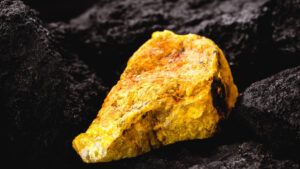Uranium explorer Marenica Energy raises over $5 million

Pic: Schroptschop / E+ via Getty Images
Special Report: Australian uranium explorer Marenica Energy (ASX:MEY) has raised $5.4 million as it looks to advance its activities in Namibia and Australia.
The company successfully raised $2.8 million through a share purchase plan in November and then raised $2.6 million in a top-up placement to institutional and sophisticated investors.
All new shares were offered at 8.8 cents, and the capital raised sets the business up to conduct further exploration activity at its Hirabeb tenement in Namibia.
The company’s share price jumped up nearly 20 per cent on Monday as the US moved closer to creating a national strategic uranium reserve.
In July, horizontal loop electromagnetic surveys of the site discovered mineralisation along a 30km stretch of prehistoric river bed, which the company says could indicate the largest uranium discovery in Namibia since Husab was identified in 2008.
Marenica managing director Murray Hill said the business’ executives “appreciate the support” of all those who invested.
“This capital raising provides Marenica with a very strong funding position to increase exploration activities on its extensive uranium tenement package in Namibia, and on activities to add significant value to the Australian uranium assets,” he said.
“These activities can be undertaken with the knowledge that the company is fully funded to undertake the proposed activities for at least the next 18 months,” he added.
Uranium price remains strong
Marenica’s capital raise comes as the US Senate Committee on Environment and Public Works passed a bill to create a national strategic uranium reserve.
The bill is expected to receive bipartisan support from the Senate and will unlock US$150 million to finance the stockpile and fund advanced reactor planning.
It will also see Chinese and Russian uranium producers excluded from the supply chain, while Australia – which already provides the country with some of its uranium needs – is expected to benefit from the changes.
The news caps off a year that saw uranium prices rally in the middle of 2020 to break past US$30 per pound and eventually reach highs above US$34 by late May.
And while the price dropped back to around US$28 per pound by mid November, it subsequently rebounded to hit US$29.55 by 2 December.
With 52 new reactors currently under construction worldwide, demand for the yellow metal is predicted to grow and potentially out-strip supply.
This article was developed in collaboration with Marenica, a Stockhead advertiser at the time of publishing.
This article does not constitute financial product advice. You should consider obtaining independent advice before making any financial decisions.
Related Topics

UNLOCK INSIGHTS
Discover the untold stories of emerging ASX stocks.
Daily news and expert analysis, it's free to subscribe.
By proceeding, you confirm you understand that we handle personal information in accordance with our Privacy Policy.








